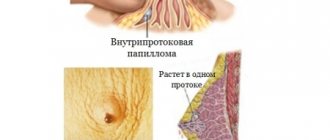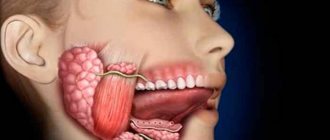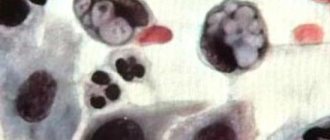What is gynecomastia in men
Translated from Greek, this term means “breast” and “woman”. From these concepts it is clear that gynecomastia is a disease in which the mammary glands develop according to the female type. This pathology is typical only for men. The disease develops at any age. More often, this diagnosis is given to men 50-60 years old. This is due to age-related changes, which are characterized by the processes of hormonal changes. Gynecomastia has several types:
- True. With this form of the disease, the glandular or connective components of the mammary gland grow. This leads to an increase in its volume to approximately 20 cm. Liposuction will not help here, because the connective and glandular tissue is denser. True gynecomastia is divided into physiological (in newborns, adolescents and the elderly) and pathological (caused by serious diseases).
- False or pseudogynecomastia. This form of the disease is characterized by the proliferation of adipose tissue of the mammary glands. Occurs in obese men. Treatment here is carried out through liposuction and subsequent weight loss.
- Mixed. In this case, all the structures of the mammary glands grow - glandular, fatty and connective. Sometimes the pathology can be one-sided.
Symptoms
One of the most obvious symptoms is breast enlargement. She becomes like a woman. In addition to visual signs, there are other signs of gynecomastia in men:
- decreased libido;
- enlarged axillary lymph nodes;
- feeling of heaviness and fullness in the chest;
- problems with potency;
- itching in the chest area;
- swelling and hardening of the mammary glands;
- an increase in the size of areas, a change in their color to a darker one;
- discharge of clear liquid from the nipples when pressed;
- change in voice timbre;
- emotional instability;
- reduction of male pattern hair.
Causes
Certain forms of gynecomastia have their own causes. In general, breast enlargement is facilitated by an increase in the level of the female sex hormone estrogen. These changes are caused by hormonal imbalance, which can be a consequence of various diseases. The causes of gynecomastia also depend on the age of the man:
- In newborns, swelling of the mammary glands is associated with the action of the mother's estrogens, which enter the womb. More often, this pathology goes away on its own after 2-4 weeks from birth.
- In boys 12-14 years old, gynecomastia occurs in 30-60% of cases. More often it is bilateral and is caused by a temporary hormonal imbalance. The disease goes away on its own within 12-24 months.
- In old age, gynecomastia can occur in many men 50-80 years old. It is associated with a decreased level of the hormone testosterone, over which female estrogen begins to predominate.
- Pike perch in the oven: recipes with photos
- Carrot salad for the winter: recipes
- Alcohol coding - prices, methods and consequences. How to get rid of alcoholism
At a young age, gynecomastia develops more often due to more serious diseases. The first to note are pathologies of the genital organs, which are accompanied by a decrease in testosterone levels. Among them are:
- congenital diseases - anorchia (absence of one or both testicles, Klinefelter syndrome, defect in testosterone synthesis;
- acquired - injuries, testicular cancer, mumps, orchitis.
An increase in the amount of estrogen, which causes breast growth, is also observed in some serious diseases, such as:
- bronchogenic lung cancer;
- feminizing adrenal tumor;
- testicular tumor;
- choriocarcinoma;
- true hermaphroditism.
The causes may also be diseases of the endocrine glands or internal organs. In this case, gynecomastia is caused by:
- chronic heart or kidney failure;
- hyperthyroidism;
- cirrhosis;
- obesity;
- “renewed feeding” syndrome, when a person begins to eat after a long period of fasting;
- dystrophy;
- leprosy;
- HIV infections.
Some medications have gynecomastia as a side effect. Among these medications are:
- Reserpine;
- Phenothiazine;
- Theophylline;
- Cordarone;
- Spironolactone;
- tea tree and lavender oil;
- calcium channel blockers used to treat hypertension;
- tricyclic antidepressants.
Symptoms
A lump in the chest, characterized by pain and high temperature of the affected area, pulsation, a visible pathogenic tubercle with a diameter of 4 centimeters, swelling and redness of the skin over the breast defect are the main indicative signs indicating the presence of the disease. In this case, there is a noticeable enlargement of the axillary lymph nodes, the chest begins to become inflamed, and this is accompanied by severe pain.
The degree of tolerability of symptoms depends on the stage at which the inflammation develops. In total, the disease has three stages: serous, infiltrating and purulent.
- Serous (initial) stage. Characterized by swelling, enlargement and increased sensitivity of the mammary gland. As a result of palpation, a slight thickening of the breast is noted. The symptoms are mild, but after this stage the axillary lymph nodes noticeably increase in size.
- Infiltration stage. The second stage of the development of the disease, which appears due to the lack of proper treatment at the first stage. There are no special differences in symptoms; existing ones are only aggravated due to the influx and accumulation of leukocytes in the affected area. It differs in that the patient’s temperature rises, the general condition worsens, and symptoms of intoxication appear.
- Purulent. The advanced stage occurs in rare cases and has pronounced symptoms. The number of leukocyte accumulations increases, the source of inflammation festers, and the pain of the affected area with intoxication increases to a critical point. The patient's temperature may exceed 39 degrees, and the mammary gland begins to change.
Nipple adenoma, in the presence of this disease, is visually manifested by bloody or clear liquid discharge. In this case, the papilla and areola acquire a reddish or dark tint. Inflammation of the nipple in men is in some cases accompanied by its deformation, itching and swelling.
Neglected cases caused by the lack of timely proper treatment, and the progression of the disease process often lead to the fact that inflammation begins to pose a particular danger. Because in most cases it leads to oncology and requires surgical removal.
https://youtu.be/HwwX-KZZjgY
Diagnosis of gynecomastia
If you experience a number of the listed symptoms, you should immediately consult a doctor in order to diagnose the disease in time. At the initial stage, it is possible to treat gynecomastia in men without surgery. During the consultation, the specialist palpates the mammary glands, checking whether lumps are present. Diagnosis also requires examination of the testicles for the presence of a tumor or injury.
If hormonal dysfunction is suspected, hormone tests are prescribed: testosterone, prolactin, estrogen and human chorionic gonadotropin. For an even more detailed study and to exclude a number of diseases, patients may undergo the following studies:
- Ultrasound of the mammary glands and scrotum;
- radiography;
- CT scan of the brain and adrenal glands.
Pathological gynecomastia
According to the classification accepted throughout the world (according to Frantz FG, Wilson JD Endocrine disorders of the breast. Williams textbook of endocrinology 1998; pp. 877-900), depending on the causes of the pathology, gynecomastia is divided into:
- Pathological gynecomastia
- Testosterone deficiency
- Birth defects
- Congenital anorchia (absence of testicles and underdevelopment of genital organs)
- Klinefelter's syndrome
- Androgen resistance (Morris syndrome - testicular feminization - and Reifenstein syndrome)
- Defects in testosterone synthesis
- Secondary testicular failure (viral orchitis, trauma, castration, neurological and granulomatous diseases, renal failure).
- Increased production of estrogen
- Increased testicular production of estrogen
- Testicular tumors
- Bronchogenic cancer and other tumors that produce human chorionic gonadotropin hormone (CG)
- True hermaphroditism
- Increased substrate for extraglandular aromatase
- Adrenal diseases
- Liver diseases
- Starvation
- Thyrotoxicosis
- Increased extraglandular aromatase
- Drug-induced gynecomastia
- Estrogens and drugs that act like estrogen (diethylstilbestrol, estrogen-containing cosmetics, contraceptives, estrogen-containing foods, phytoestrogens).
- Drugs that enhance the endogenous formation of estrogen (chorionic gonadotropin, clomiphene).
- Drugs that inhibit testosterone synthesis or its effect (ketoconazole, metronidazole, cimetidine, etomidate, alkylating drugs, flutamide, spironolactone).
- Drugs with an unknown mechanism of action for gynecomastia (isoniazid, methyldopa, calcium channel blockers, captopril, tricyclic antidepressants, penicillamine, diazepam, as well as marijuana, heroin, etc.).
Simply put, the reason for the development of gynecomastia is the predominance of estrogens (female sex hormones). However, such a predominance can be true (overproduction of estrogen) or relative, when the synthesis of male hormones is reduced.
Many conditions lead to a relative deficiency of testosterone (reduced production). Klinefelter's syndrome, testicular feminization, Reifenstein syndrome, secondary testicular failure (the result of diseases such as viral orchitis, trauma, castration, neurological and granulomatous diseases, renal failure) and defects in testosterone synthesis deserve special attention.
Klinefelter syndrome is a genetic disorder. Men have a certain set of chromosomes that determine external characteristics: tall stature, long limbs, eunuchoidism, gynecomastia, increased secretion of female sex hormones, a tendency to obesity, as well as mental disorders. Unfortunately, its prevalence is not as low as we would like. Treatment is carried out with male sex hormones to correct secondary sexual characteristics.
Testicular feminization and Reifenstein syndrome are combined into one group. Both conditions are caused by cell insensitivity (resistance) to testosterone. As a result, there is an obstacle to the path of testosterone to the cells. That is, it is there, but cannot act on tissue.
Testicular feminization syndrome develops when the cells have an inferior structure and cannot accept testosterone (no receptors). In this case, the set of chromosomes is characteristic of men, and the appearance is feminine, therefore the syndrome is also called pseudohermaphrodism. There is underdevelopment of the genital organs and the testicles are almost always present. There is no treatment for this syndrome.
Reifenstein syndrome is a genetic disease, the essence of which also consists in impaired tissue sensitivity to androgens. Reifenstein syndrome is similar in appearance to Klinefelter syndrome: hypospadias (an abnormality of the development of the penis, in which there is an incorrect location of the opening of the urethra), gynecomastia, eunuchoidism, atrophy of the seminiferous tubules and often azoospermia (lack of sperm in the seminal fluid - infertility).
Treatment in this case comes down to androgen replacement therapy.
Treatment of gynecomastia in men
After confirming the type of gynecomastia, the doctor prescribes a specific treatment for the patient. Today medicine offers several treatment options. In newborns, treatment is not required, because gynecomastia in them disappears in most cases on its own. In adult men, therapy begins with hormonal drugs. If it does not bring a positive effect, then surgical intervention is indicated, including removal of the mammary glands.
- Why doesn't the computer see the phone via USB?
- How to attract luck and money into your home, into your life
- Anaprilin - what helps
Without surgery
Since gynecomastia is caused by hormonal disorders in men, it is treated with drugs containing hormones. Although other medications are often used. It all depends on the age of the patient and the type of gynecomastia. In general, the following groups of medications are used:
- hormonal – to correct hormonal imbalances in a man’s body;
- bromocriptine - suppresses the production of prolactin by the pituitary gland, more often used to treat adolescents during puberty;
- vitamins - used in combination with basic medications.
Drug therapy
If gynecomastia is caused by taking any medications, then you need to stop using them or reduce the dosage. In other cases, treatment is carried out with medications, such as:
- Testosterone. Indicated for patients with low levels of the hormone of the same name. Often prescribed to older people.
- Clomiphene. This is an anti-estrogen that suppresses the synthesis of the female sex hormone estrogen in the patient.
- Tamoxifen. Used in more severe cases of male gynecomastia. Belongs to the group of selective estrogen receptor modulators.
- Danazol. The drug is a synthetic derivative of testosterone. It reduces estrogen synthesis in the testicles.
Surgical methods
If drug therapy is not effective, surgical treatment is indicated. In case of true or mixed form, a mastectomy is performed. This is an operation to remove the breast and then correct the area under the nipples so that they do not collapse after the operation. For false gynecomastia caused by obesity, liposuction is necessary, during which all the fat is pumped out from the affected area. If the cause of gynecomastia is a malignant tumor, then it is also removed through surgery.
Treatment
Only comprehensive measures, including adequately selected therapy, will help effectively get rid of the pathology.
Treatment is aimed at eliminating the infection spreading in the breast tissue, relieving the inflammatory process and preventing the formation of new lesions. At the same time, pain relief occurs.
An approximate treatment regimen may look like this:
- Antibiotics are necessarily prescribed, the action of which is aimed at eliminating the source of infection. They should be selected exclusively by a doctor based on the infection that has manifested itself. It is important to take antibiotics as a course, and even after improvements do not interrupt treatment.
- Anti-inflammatory. For these purposes, NSAIDs or other drugs that can block inflammatory reactions can be used.
- Painkillers. Mastitis is a rather painful pathology, especially when suppuration occurs in the mammary gland. It is difficult to cope with such symptoms, so painkillers are almost always prescribed.
- Surgical intervention. If the disease progresses to the stage when purulent, serous lesions form, then the pathology can only be dealt with surgically. How serious the operation will be depends on the number and location of purulent accumulations.
- Physiotherapy. Procedures are prescribed to promote tissue restoration, stimulate cell regeneration, and the healing process.
If mastitis in a man develops against the background of abnormalities in the endocrine system, then hormonal or other drugs are prescribed that can stabilize the balance in the body.
Forecast
Gynecomastia has a favorable course in adolescents and newborns, because it almost always goes away on its own. In other cases, the outcome depends on the specific disease that caused breast enlargement in men. But even in severe cases, for example, with scarring, surgical methods help restore the normal appearance of the mammary glands. In general, this disease is not so dangerous, but if it persists for a long time, it significantly increases the risk of developing complications, including cancer.
Inflammation of the mammary glands
This pathology is much less common. The inflammatory process in the mammary glands in men can develop for various reasons, including:
- intoxication of the body;
- cirrhosis of the liver;
- chronic renal failure;
- cardiovascular failure;
- HIV infection and AIDS;
- trauma to the chest area.
Any inflammatory process, regardless of location, leads to vascular spasm and stagnation of blood in the area of inflammation. If the inflammatory process is localized in the chest area, then blood stagnation occurs at this place with the subsequent development of edema. Often, swelling can be mistaken for gynecomastia, but this condition is caused by other infectious or traumatic causes and resolves over time with recovery.
Oncological diseases
Rice. 3 - Breast cancer in men.
One of the rarest forms is the occurrence of benign and malignant neoplasms in the mammary glands in men. Tumors from the glandular tissue of the breast are a very rare disease, since this tissue is inactive and undergoes slow division.
Unlike breast cancer in women, the malignant form in men is very rare and does not have a high rate of progression.
With breast cancer in men, patients are bothered by severe pain in the chest area, which helps in preliminary diagnosis.
Diagnosis of the disease
The initial stage of diagnosis is collecting anamnesis and visual examination of the patient’s body.
- Examination by a doctor: questioning the patient with an assessment of symptoms and analysis of family history;
- percussion, auscultation;
- palpation of the chest and lymph nodes.
- general blood in urine;
- Ultrasound;
A doctor of any specialty can detect cancer. In most cases, patients come to a therapist or surgeon with symptoms of the disease. To clarify the diagnosis, an examination by a mammologist-oncologist is necessary.
A comprehensive examination includes:
- inspection;
- palpation of the mammary glands and local lymph nodes;
- radiography (mammogram);
- Ultrasound of the mammary glands;
- tomography (CT, MRI);
- aspiration biopsy;
- examination of nipple discharge for atypia;
- examination of discharge from an ulcer for atypia;
- hormonal profile;
- tumor markers (Ca-15-3, BRCA, CEA).









